Q&A – Ask Neil: July 7, 2022
(Please read these instructions carefully.)
I hope you’re enjoying this new Q&A format. We’re still making minor adjustments, but it’s getting better.
• Click here to post your question.
• After you submit your question, a new window will pop up giving you the address to which you can e-mail a photo to accompany your question. Clear, medium-resolution photos (not thumbnails, please).
• Please only post your question one time.
• One question per reader, please.
• Please use this only for posting questions – not for standard emails.
• Watch for your answer in the following week’s e-gardens.
• I choose those of greatest general interest. For example, plant IDs seldom make the cut.
• I must have your first name or initials.
• I must have your city or county. (Texas is a very large state.)
QUESTION 1
FEEDING CRAPE MYRTLES IN ST. AUGUSTINE TURF
Question: I understand that crape myrtles are heavy feeders. However, mine have roots that extend out into St. Augustine turf. I also know that I’m not supposed to fertilize my St. Augustine until September. How can I feed the crape myrtles without hurting the lawn? Mark R., Colleyville.
Answer: If you fertilized your St. Augustine in April and again in early June the crape myrtles should be fine. If you can apply nitrogen solely in beds where it wouldn’t hit the St. Augustine, at least do that. Either way, you’ll get good blooms. (I can tell that you’re paying close attention.)
QUESTION 2
HOW TO HANDLE CANNA STEMS THAT HAVE FINISHED BLOOMING
Question: When a stalk appears on my cannas and it has no green flower buds, should I cut it back and, if so, by how much? Wilma S., Brazoria Co.
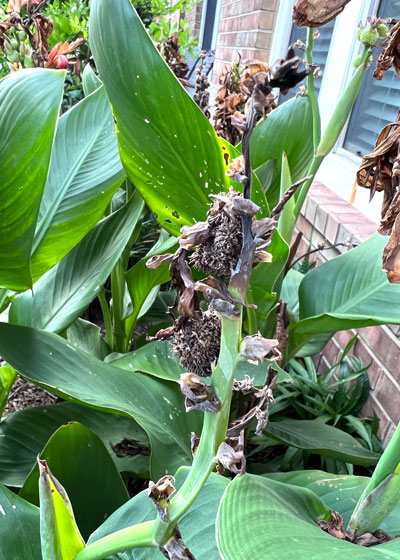
Answer: You can cut canna stems that have finished flowering back into the centers of the plants. I checked the website of Horn Canna Farms in Southwest Oklahoma. They raise 130 acres of cannas, so I figured they would know. They suggest cutting just below the spent bloom head. Cutting too low, they say, can slow production of future blooms.
QUESTION 3
WHY DOES LIVE OAK HAVE SO MANY YELLOW LEAVES?
Question: Why does my live oak have so many yellowing leaves? Is this due to heat. Or not enough water? Or chlorosis? I am afraid of oak wilt. Elaine M., Brazos Co.
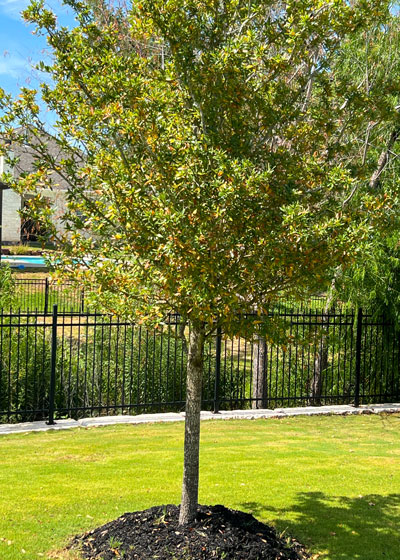
Answer: Let’s start by ruling out what we know it is not. This is not iron deficiency (chlorosis). That shows up on newest growth first, and this is just the opposite. It’s not heat, because live oaks are native to areas where these temperatures are normal. And it’s not oak wilt. The look just isn’t right. It could be that the tree got too dry. That would cause older leaves to turn yellow and shed. (Think about how a poinsettia does that if you allow it to wilt.) That mound of soil and mulch actually repels water and makes it more difficult to get water down to the critical roots. If this were my tree, I’d pull that “mulch volcano” away from the trunk and create a basin to hold water while it soaks into the soil.
However, I feel like there’s a chance this tree might have suffered cold damage in February 2021 if it was growing in this location back then. I see outer dieback that has been typical of live oaks that were hurt by that cold. I also think I’m seeing modest amounts of bark cracking and splitting vertically if I look really closely. Keep an eye on that. There isn’t anything you can do at this point except wait. Hopefully it will recover and take off with lots of new growth.
QUESTION 4
SHOULD WE MODIFY WATERING, FEEDING SCHEDULES IN HOT WEATHER?
Question: I’m watering my pots every day now with this extreme heat. Should I be altering my “general” watering as a result of the heat? Longer times or more frequent waterings? How about fertilizing? Do you feed your plants more often? Karen D., Southlake.
Answer: I water my plants when they’re dry. They dry out more quickly at 104F than they did at 94F or 84F, so the answer is yes, my schedule has changed. I apply a water-soluble, high-nitrogen fertilizer to all my container plants every third or fourth time that I water them, so that has also stepped up. But I do not fertilize St. Augustine in the heat due to the gray leaf spot fungus that crops up after nitrogen is applied in summer.
QUESTION 5
WHAT TO DO WITH A CRAPE MYRTLE THAT CAN’T SUPPORT ITSELF?
Question: We had one of those rare 2-inch rains a couple of weeks ago and this happened to our crape myrtle. My husband and I were able to tie the branches back up. What more can we do? Mary J., Bedford.
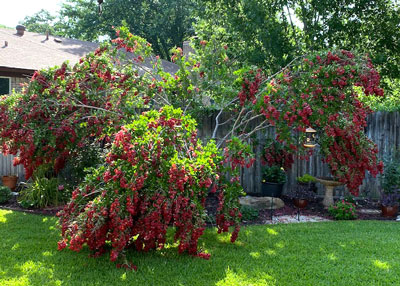
Answer: It’s almost unheard of for a crape myrtle to splay out like this unless it (1) is growing in shade or (2) has been topped and has produced long shoots of regrowth the following spring. If it’s in shade (doesn’t appear to be), move it to a sunny location next winter. If it’s been topped (or even if it hasn’t), you’ll need to retrain it as a tree. Trust me on this next part of my answer even if it sounds bizarre. Cut the trunks completely to the ground and train the resprouts next year. You won’t believe how quickly they will grow back and how nice the plant will look. I wrote this information on the website of our Crape Myrtle Trails of McKinney. Scroll to the bottom to see an example of what I’m describing.
QUESTION 6
HOW TO COPE WITH ARMADILLOS
Question: What is the best way to remove and prevent armadillos? They’re making a mess of my yard. Shiv K., San Antonio.

Answer: We live in a rural area and have been, for 45 years, blessed with armadillos that come in from adjacent fields and stream banks. Trapping has been my best solution. I’m not a killer, so we take them several miles to a release spot where they won’t bother landscapes or farms. We’ve used several homemade traps in the past, but I just bought three raccoon-sized Havahart humane traps. We’re going to try them this year. If they work, they’ll be a lot easier. Click here for additional tips I have on my website.
QUESTION 7
WHAT GRASS FOR LAKE ATHENS AREA?
Question: Our builder at Lake Athens has suggested a hydomulched mix of centipede and bermuda seed in August. We are thinking bermuda and St. Augustine sod for appropriate areas. Please advise. Myra S. Dallas/Athens.
Answer: I’m not a fan of mixing species of grasses. One or the other ends up predominating and the other looks like a weed invader. As a result, the centipede and bermuda mix wouldn’t be my choice. Either one would work well at Lake Athens, but don’t let time slip away. August is just about your latest planting time. If you’re going to be using bermuda elsewhere in your lawn with St. Augustine in other parts of your yard, I would use bermuda instead of centipede. Again, that’s just to limit the number of species in your lawn. (I hope I’ve understood your question correctly.)
QUESTION 8
CONCERN OVER WHETHER OVERLAPPING ROOTS POSES A PROBLEM.
Question: Should I be concerned with the upper root overlapping the lower root of my 40-year-old live oak? Ed G., Dallas.
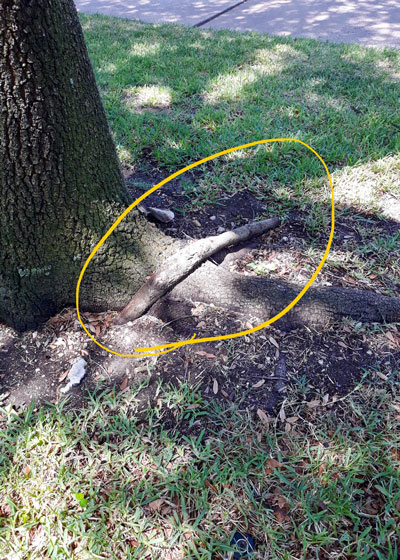
Answer: Yes. It should be removed late this fall. The two roots will eventually grow together, and this smaller one will embed itself in the larger root, thereby partially cutting off free flow of water and nutrients through it.
QUESTION 9
DOES MAGNOLIA 3 FEET FROM HOUSE NEED TO COME DOWN?
Question: I moved to my current home in 2014. There is a large magnolia tree 3 feet from the foundation. I also have pool equipment to the right side of the tree. I have been told that the tree needs to come down due to invasive roots. Sherry W., Wills Point.
Answer: I’ll assume that to be a request for my opinion. 🙂 I would start by hiring a certified arborist to examine the tree and its roots on site. I don’t consider a magnolia’s roots to be any more invasive than any other tree’s roots. Granted, 3 feet isn’t very far. I would be equally concerned about limbs rubbing the roof and the trunk growing large enough to push into the eaves. The arborist can handle those decisions for you. You probably have time to make that decision. It also would depend on whether this is a regular southern magnolia or one of its dwarf selections.
QUESTION 10
EAGLESTON HOLLIES HAVE PURPLE/GRAY LEAVES.
Question: Several of my Eagleston hollies are struggling. It starts with purple blotches in the centers of the leaves. Then they turn gray and drop. They are about 5 years old. Is this a fungus? Matthew G., Southlake.
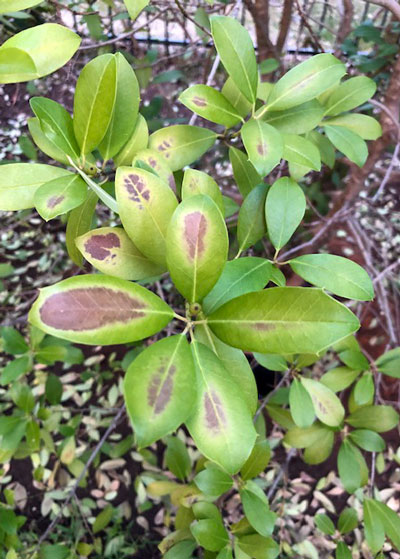
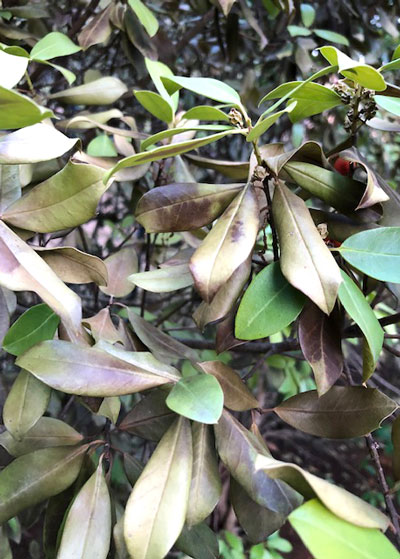
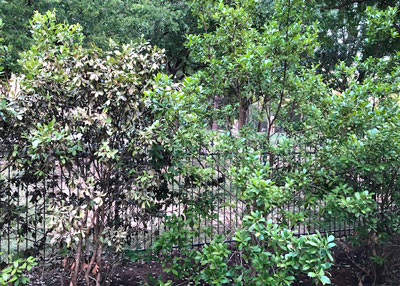
Answer: While I’ve answered questions on Eagleston hollies in recent weeks, and while I’ve said that I really don’t recommend them along I-35 and west, your question is quite different. Southlake has soils that are conducive to this acid-loving holly (unlike the black clay soils of most of the rest of the Metroplex).
Your plants are showing classic symptoms of moisture stress. I’m a holly fanatic. I have 30 or more types in our Collin County landscape (but not Eagleston), and on those occasions when I have let one get too dry, this is exactly what it has looked like. Nothing else gives this look. I wonder if you have a sprinkler system serving those several plants and if the head that is supposed to be watering those plants might be out of service. Perhaps you have a break in that station so that there isn’t enough pressure. Somehow there just hasn’t been enough water to these plants. You can try watering them more deeply now, but I suspect that you’re going to end up having to replace them. It may mean that you’ll end up replacing the entire row. In that case, I would switch to some other variety that you know will do well, perhaps Nellie R. Stevens, Oakland or Mary Nell.
QUESTION 11
WHAT IS WRONG WITH THIS BUR OAK?
Question: I am extremely worried about my bur oak. This has happened over the past four days. The same thing happened in June 2021. I had a certified arborist evaluate the tree. He exposed the root flare and gave it a deep root feeding. Micki R., Cleburne.
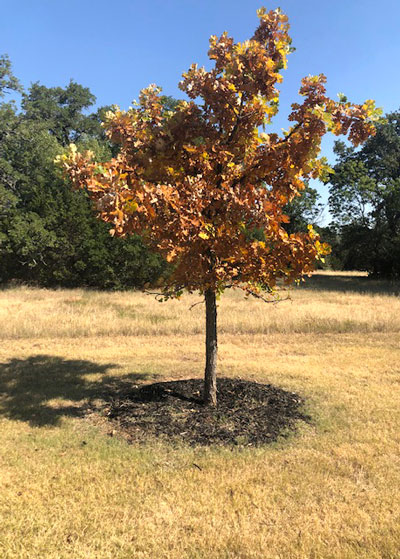
Answer: Your photo wasn’t high enough resolution for me to enlarge. I wanted to see the trunk. What I’m about to write is something I’ve not written before: I wonder about radial shake in your tree’s trunk. That’s the vertical cracking of the bark that has been so common with live oaks and, to a lesser degree, with Shumard red oaks after February 2021’s cold. The bark ended up separating on many of the oaks, thereby cutting off the flow of water and nutrients, also manufactured sugars from the soil to the leaves and from the leaves back down to the roots. Bur oaks are the most cold hardy of all three species, so I would be surprised to see radial shake, but I think I see cracks in your tree’s trunk. Or maybe it’s just old, tired eyes. There just isn’t much reason for a tree that put out that many healthy, vigorous leaves suddenly to turn brown like this. Even if the root flare had had issues, the tree was still very vigorous two months ago. I just can’t get any closer with only the photo to go on.
QUESTION 12
WHAT CAUSES LINES IN ST. AUGUSTINE?
Question: My parents are having issues with their St. Augustine lawn. Do I need to buy a fungicide? Laura B., Mesquite.
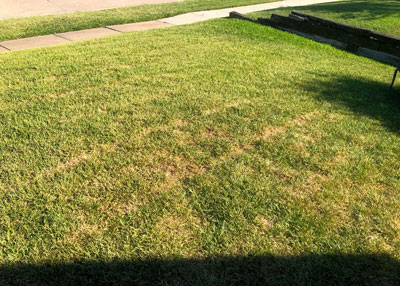
Answer: I think you’re talking about the imprints of the lawn mower wheels. That’s a phenomenon known as “heat tracking.” It’s relatively minor (unless it happens to one’s parents’ lawn). Here is an extreme example reported by a man who has been writing about it for more than a decade.
QUESTION 13
WHAT ARE TINY WHITE SPECKS?
Question: What are the tiny white specks on my tropical hibiscus? I’ve sprayed with an insecticide but it hasn’t helped. Pam M., Waxahachie.
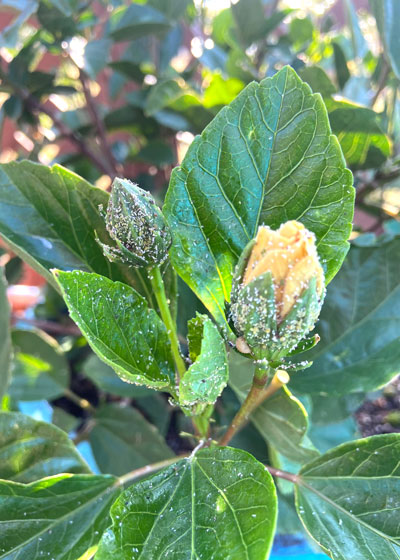
Answer: Good old All-American aphids. Most insecticides will eliminate them, but you need to be careful to use one that is cleared for use on hibiscus. They can be damaged by many common insecticides. You could even start by trying a high-pressure spray to knock them off. Aphids have the devious ability to give rise to living young without mating, so populations can build in a big hurry.
QUESTION 14
WHY ARE MY CYPRESS TURNING BROWN?
Question: I just had my irrigation moved around and this has happened. Too dry? Too wet? Right now I’m doing three days a week for 10 minutes. Tamra T., McKinney.
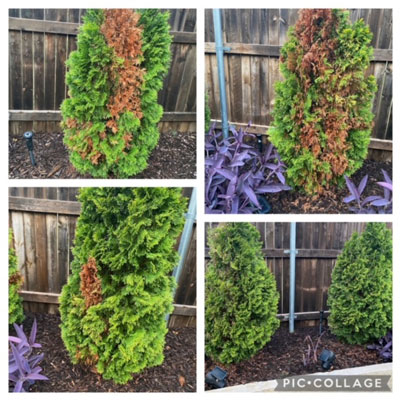
Answer: It has nothing to do with irrigation. If you look closely you’ll see the classic gray-green look that tells you that spider mites are present on the plant in the lower right. Soon those branches will be brown as well. Unfortunately, this plant isn’t thrilled with the heat this year. But the spider mites are. They thrive in it. Thump one of those twigs over a sheet of white paper and you’ll see dozens of tiny specks start to move about freely after a few seconds. They’re almost microscopic, so be prepared to use a hand lens. Sadly, even using a product that has spider mites listed on its label may not help because the summer heat will probably take the plants down anyway.
QUESTION 15
IS SECOND TREATMENT FOR BARK SCALE NEEDED FOR CRAPE MYRTLES?
Question: I had a terrible case of bark scale on my crape myrtles last year. I followed your advice and treated with Imidacloprid soil drench in mid-May. I’ve not had any scale this year. Should I repeat the treatment sometime this summer? Faylene H., Ben Wheeler.
Answer: The entomologists with Texas A&M have not recommended a follow-up treatment so I’m not going to suggest it, either. Late May and June are when the biggest round of activity happens, and the drench used preemptively will usually give great results. I would sit tight the balance of this growing season and see what plays out.
